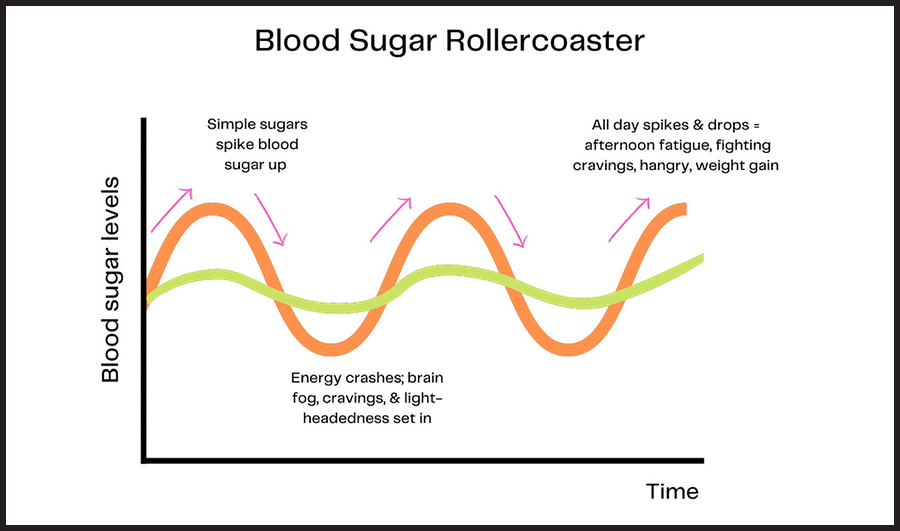Eliminate Cravings, Brain Fog, and the Afternoon Slump

Blood sugar regulation is an aspect of our biology relevant to everyone. It has major implications for how we feel and function daily. If you experience energy swings, brain fog, irritability, light-headedness, or cravings throughout the day, you could be dealing with blood sugar dysregulation.
Fluctuations in blood sugar throughout the day are completely normal, but large spikes and their subsequent drops cause harm. Most people’s blood sugar curves look like a rollercoaster, going up and down between states of hyper- and hypoglycemia, when their curves should look like smooth hills.

Hyperglycemia (high blood glucose) occurs when too much glucose is in the bloodstream. This happens if your body doesn’t produce enough insulin or is unable to properly use the available insulin to move glucose from the bloodstream into the cells. This is referred to as insulin resistance (IR).
Hypoglycemia (low blood glucose) occurs when too little glucose is in the bloodstream. Most commonly, this occurs a few hours after a meal that quickly spikes blood sugar levels, causing a subsequent blood sugar plummet. Simple carbohydrate foods — white rice, pasta, bread, potatoes, cakes, pastries, pancakes — are often the culprits.
In the short term, insulin resistance can cause cravings for carbs and sugar, weight gain (especially belly fat), irritability, feeling tired, headaches, low moods, shakiness, and even memory issues.
Progression of IR can lead to chronic issues such as type II diabetes, hormonal imbalances, kidney disease, and even Alzheimer’s disease.
What causes insulin resistance?
Insulin resistance begins years before a diagnosis of type II diabetes. Think of diabetes as a continuum: Before one will reach the diabetic threshold, there may have been decades of abnormal glucose metabolism.
Of the many factors that can contribute to insulin resistance, the most modifiable and effective one is what you eat. Regularly eating processed foods, simple starches, and sugar, alongside overeating, grazing, and dehydration, all contribute to suboptimal glucose metabolism. Certain vitamin and mineral deficiencies may also play a role.
Aside from diet, lack of exercise, poor sleep, chronic stress, hormonal changes, certain medications, and gut issues may also cause abnormal blood sugar levels. It is essential to consider all these factors when trying to optimize blood sugar regulation.
How do I keep my blood sugar stabilized?
To avoid blood sugar spikes and drops, we must consume foods rich in soluble fiber, quality protein, and healthy fats while minimizing the refined carbohydrates, fried, and high-sugar foods in our lives.
Dietary strategies can help flatten the glucose curve. For example, pairing a carbohydrate (like a banana) with a fat (like peanut butter) significantly reduces the glucose spike that would have resulted from eating the banana on its own. This strategy of combining carbohydrates with protein, fat, or fiber has proven effective.
Certain phytonutrients have also been shown to help lower blood sugar, such as fenugreek seeds, cinnamaldehyde from cinnamon, isoflavones from soybeans, acetic acid from vinegar, and berberine from the goldenseal plant.
Additionally, exercise – especially resistance training – is a proven way to improve blood sugar levels. Not only are you able to transport more glucose into cells, but over time, your insulin receptors become more sensitive and effective in clearing excess sugar from the bloodstream.
Practical meals to get you started:
A carbohydrate-rich breakfast like cereal, toast, bagels, pancakes, pastries, or oatmeal, sets your blood sugar curve up for disaster. Healthy fats and proteins in the morning help sustain energy and fend off cravings throughout the day.
Here are some examples of well-balanced breakfasts:
- A vegetable-filled omelet with organic goat cheese.
- Chia pudding with cacao powder, sliced almonds, and wild blueberries.
- Unsweetened Greek yogurt with raspberries, coconut flakes, and chopped walnuts.
- A green smoothie with grass-fed whey protein powder, pineapple, kale, avocado, and almond butter.
When we take control of our blood sugar, we sustain energy, combat cravings, optimize cognition, improve metabolism, and prevent chronic disease.






